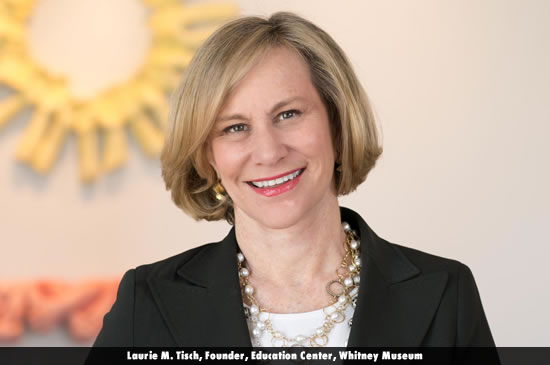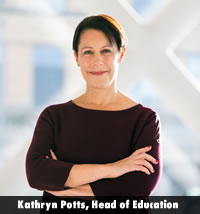All Eyes on the Whitney Museum and Laurie Tisch
By Joan Baum, Ph.D.

It’s understandable that when The Whitney Museum of [Modern and Contemporary] American Art re-opened May 1, 2015, all eyes were on the spectacular glass design inside and out. Designed by the celebrated architect Renzo Piano and situated between the High Line and the Hudson River, the new building, with its dramatic expanse and vast new exhibition spaces, caused jaws to drop, pens to flow and nonstop crowds to fly downtown. Now it’s the turn of the new and expanded Whitney education programs to garner attention, and what an extraordinary number of programs there are for all ages, with primary focus on the newly opened Laurie M. Tisch Education Center, arguably the crown jewel in the already well established gem of the Whitney Education Department.
 According to Kathryn Potts, the Helena Rubinstein Chair of Education at the Whitney, a position’s she’s held with joy for seven years though she’s been at the Museum for 18, the Center is not just beautifully imaginative and incredibly responsive to its diverse urban community, but unique. It is the first such dedicated museum education space at the Whitney itself and in the New York City art world. Typically, areas for education in museums are set in different wings, in a separate building or in a basement. The Tisch Center, however, is in the center of things: a prominent third-floor location with glass that removes a sense of barriers carries through the museum’s mission to be an open, accessible and welcoming place. The center in effect says to visitors – especially those coming to the museum for the first time - this is for you, you are at V.I.P., we have set aside special gallery areas for you, and visiting times, when you will can see and participate, away from the general public. And free admission for those under 18 (who are also given free passes to come back with their families) is intended to encourage return visits and learning continuity. Special outreach events, such as Senior Open Access Day and programs given over to welcome low-income neighborhood residents and speakers of ESL also form an essential part of Whitney education. For Ms. Potts, who comes from a long line of teachers, offering not just traditional tours and their accompanying activities but innovative programs that turn on interactive activity is critical to realizing the museum’s goals.
According to Kathryn Potts, the Helena Rubinstein Chair of Education at the Whitney, a position’s she’s held with joy for seven years though she’s been at the Museum for 18, the Center is not just beautifully imaginative and incredibly responsive to its diverse urban community, but unique. It is the first such dedicated museum education space at the Whitney itself and in the New York City art world. Typically, areas for education in museums are set in different wings, in a separate building or in a basement. The Tisch Center, however, is in the center of things: a prominent third-floor location with glass that removes a sense of barriers carries through the museum’s mission to be an open, accessible and welcoming place. The center in effect says to visitors – especially those coming to the museum for the first time - this is for you, you are at V.I.P., we have set aside special gallery areas for you, and visiting times, when you will can see and participate, away from the general public. And free admission for those under 18 (who are also given free passes to come back with their families) is intended to encourage return visits and learning continuity. Special outreach events, such as Senior Open Access Day and programs given over to welcome low-income neighborhood residents and speakers of ESL also form an essential part of Whitney education. For Ms. Potts, who comes from a long line of teachers, offering not just traditional tours and their accompanying activities but innovative programs that turn on interactive activity is critical to realizing the museum’s goals.
Integral to the design of new space and new programming is that the museum is integral to the area. “We didn’t want to be a giant grey spaceship downtown,” Ms. Potts says. She congratulates the vision of the museum’s administrators and advisory board in anticipating needs and effecting a variety of programs to carry them out and make the museum a true resource, especially in the neighborhood. She laughs, recalling how, when it was announced that the Whitney was going downtown, arts people on the Upper East Side assumed that there would be lament among Whitney staff in moving away. “But the Whitney never was on Museum Miracle Mile,” Ms. Potts points out. They were on Madison and were hardly special in being the only arts institution around. She includes in this designation of being special the fact that the Whitney is an “American” museum and reflects the considerations of planners to encourage visitors to reflect on what makes art American and what in American culture encourages and engages artists to do what they do. Thus, the new Whitney education programs have a cultural as well as aesthetic purpose. As its website indicates, Whitney education programs, taking their philosophical prompt from the American philosopher and educator, John Dewey’s classic innovative 1934 text about learning by doing, Art as Experience, “ are designed to “integrate perception and knowledge in profound and lasting ways,” by urging visitors “to slow down, look closely, and engage directly with works of art.” The hope is “to better understand the world around us.” Three “Rs” inform all the programs: research, responsiveness and reflection.
Readers of a certain age may remember, none too fondly, school trips to museums – boring, obligatory, glazing-over tours that pressed unprepared and uninterested kids and teens through room after room of pictures and artifacts they merely looked at. The Whitney programs are 180 degrees from such inert, uncreative and uncritical experience. An impressive amount of planning ensures that all students feel themselves welcome – students from public, private and underperforming schools -- starting with four-to-five year olds, “Whitney Wees,” and focusing on teens (“they think hanging out on the terraces is really cool”). The demographic also includes seniors, low-income folks, the blind and vision impaired, recent immigrants and refugees, as well as those who identify as LBGT. Participation, for those who want it, covers drop-in activities and studios for interactive hands-on experiences.
Of course, some of Whitney’s educational initiatives have been around for a while, and in fact, as Ms. Potts points out, teens from years ago, now in their 30s, with whom the Museum keeps up, can serve as evaluators, informing personnel how education programs from years ago proved formative. “Whitney Ambassadors,” a teacher exchange program that meets every Monday also encourages creative pre-and post-activities for classroom and online, imaginative ways to enrich curricula and enhance Common Core skills. It’s all about “relationships” Ms. Potts says.#
This article is the first in a series on the new and expanded Whitney Museum of American Art.
